Posted: September 15th, 2010 | Author: Halbe | Filed under: Italy | 6 Comments »

Waiting in the hot sun in the line outside the Academia in Florence, you begin to wonder if seeing the statue of David is really worth it. You’ve seen the pictures and you’ve studied him in class. Can seeing it really be that big of a deal?
I am here to tell you that yes, it’s that big of a deal. Walking into the museum you enter into a room with walls displaying alters and other art. You skip it because really, you’re there for one reason. Going through the door into the long hallway, you see him. Seventeen feet tall, he’s perched on his pedestal eyeing Goliath and holding the stone which would make him famous.
The sight stops you in your tracks. He is the perfect man: strong, handsome, confident but not cocky. Frankly, he’s hot. You look in the guide book, learning secrets of the statue. It tells you to look at his large hands (large, for they carry out the will of God), see damage to the left foot from when frustrated artist attacked it with a hammer in 1990, and look at the depth in his eyes.
The book instructs you to walk around the statue and appreciate the incredible detail Michelangelo put into his creation. Look at the perfect man’s rear end? This is “art appreciation” I can get into. But does it deliver? Yes. Yes it does.

When you go to Florence, go to Uffizi, go to the Duomo if you need to, but please, leave time for the other side of David.
Posted: September 14th, 2010 | Author: Halbe | Filed under: Amalfi Coast, Italy, Unexpected Adventure | 1 Comment »
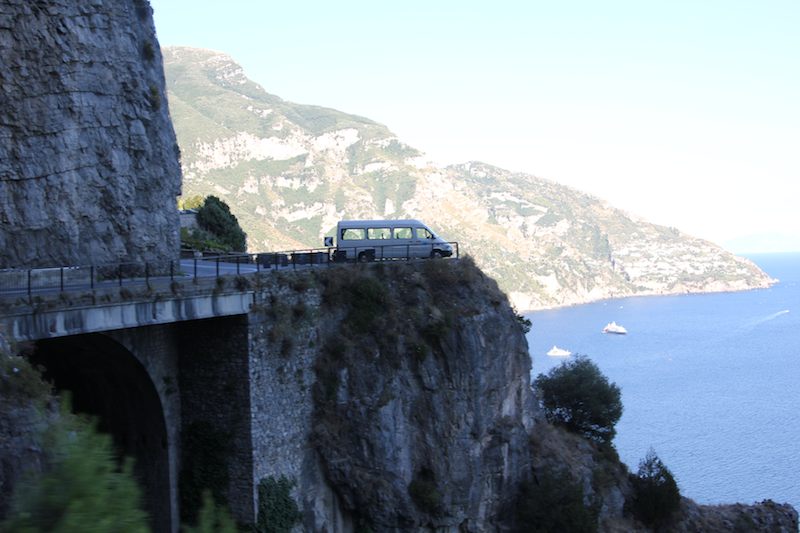
Amalfi coast – you think of breath-taking views, houses perched on the hills and beautiful teal blue water. What you don’t think of is the ride out there – a bus that practically takes up the entire road. Each bus is filled with dozens of tourists with dropped jaws and conflicting emotions toggling between amazement and acute fear.
The Amalfi coast has one road connecting all the small towns which was not built with mass tourism in mind. Looking out the window, the 3-foot tall wall separating us from a deadly fall, disappears. All you see is a sheer cliff ending in the Mediterranean Sea. It’s as close as you’ll come to flying.
The driver of each bus takes their job very seriously and is talented. As they slowly, and I mean slowly, pass one another on a curve, they have secret hand signals indicating who’s going where and how they’ll make it past one another. Going around each twist and turn they honk 5-7 times alerting all other drivers they’re taking over the road. They squeeze through spaces so small I could practically touch my nose to the side view mirror of the passing trucks.
What I kept thinking? L.A. and New York bus drivers have no idea how easy they have it.
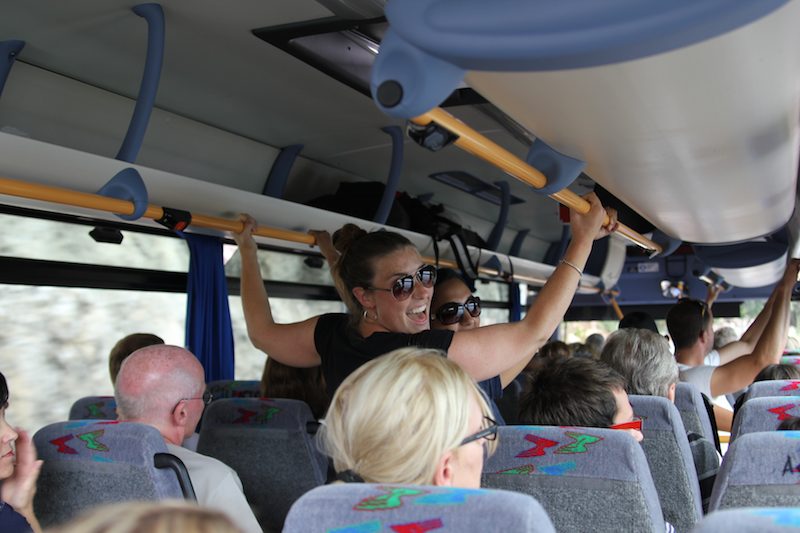
Posted: September 2nd, 2010 | Author: Halbe | Filed under: Uncategorized | 7 Comments »
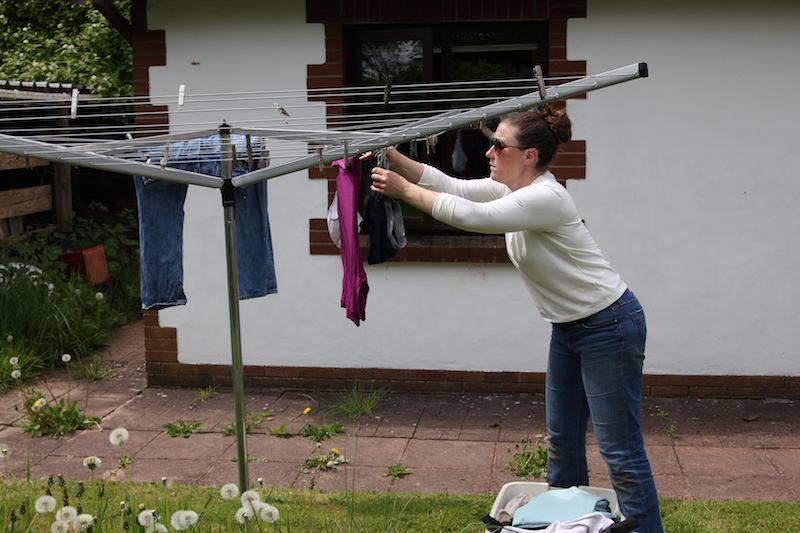
A consistent change Devon and I have had to make on this trip involves our laundry – we don’t use dryers, we use clotheslines.
When we first used one in England we thought it was a bit of an anomaly. We didn’t mind using it, but thought it was kind of a pain in the butt to coordinate our laundry with weather. Then we went to Wales. They too had a clothesline. In fact, every place we’ve visited has had a clothesline. Many don’t even have dryers.
So, what’s up with the states? Why don’t we use clotheslines? I know we used to, so where have all the clothes lines gone? I grew up with a dryer my whole life. You only had a clothesline if you didn’t have the money to buy a dryer. The U.S.’s attitude of quick, easy and unconcerned with environmental impact, I think, is well illustrated with the disappearance of the clothesline.
Recently, for obvious reasons, there’s a lot of talk of energy conservation, alternative energy etc. I think using a clothesline is one of the easiest and quickest ways to make a clear and significant impact. If you live in an area that has sun any time of year, I say use a clothesline.
# 10 on our list of things to have when we go back: clothesline.
Posted: September 1st, 2010 | Author: Halbe | Filed under: Uncategorized | No Comments »
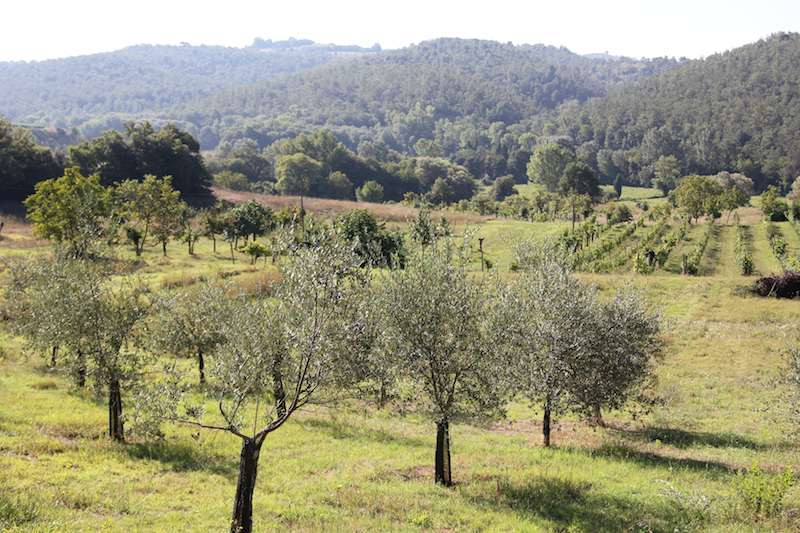
At our last place in Tuscany, we were helping on a smallholding (property with a farm under 50 acres) that had a small vineyard and olive grove. Devon and I worked in the olive grove for a bit and learned a lot about olive trees. The most interesting part was the trimming.
An olive tree would virtually be a bush if it weren’t for a whole lot of pruning and shaping. An olive tree will just grow branches anywhere it can. In fact, if a tree has been frozen due to cold weather, or had appeared to be “dead,” the solution is to cut the tree down to a stump. New branches will grow out of the stump, and voila, the olive tree is back.
Part of the pruning process was to open up the center. Each olive tree should have a dome like center with little to no branches in the middle. To create and maintain this shape, Devon and I were charged with cutting out all the suckers and any branches that were growing straight into the center.
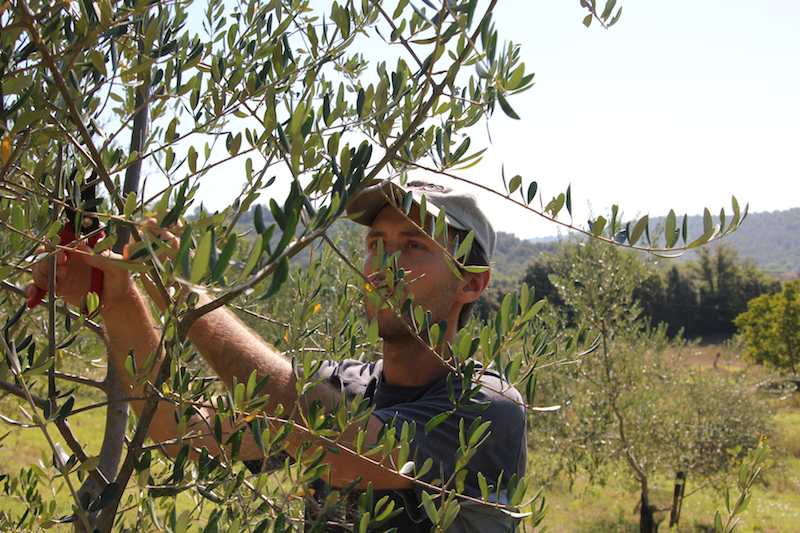
At first, we weren’t sure how to tell if the branch was a sucker. But, eventually, we got the hang of it. The suckers were usually new growth and the bark was lighter than the rest of the tree. Anything growing right into the center should be cut. A branch that looked like it could be coaxed to grow away from the center should be pulled out and guided to point down. In the end, you want a tree with branches primarily pointing down at the ground with a hollow-esque center.
Olive trees take a while to grow, but can also last forever. The trees we pruned were four years old and pretty small. They were just starting to produce olives. To make his olive oil, our host would harvest the olives by hand and then send them to the co-op which creates the oil for him. Financially, it made more sense to have the oil produced by the co-op.
We were able to enjoy his olives and olive oil. I loved both – they tasted so authentic and “fresh,” (which is a strange thing to say about something that’d been sitting in a jar for five years). Devon, however, thought the oil was lovely but the olives were too bitter. We hope to try more olive oil and olives while we’re out here to compare.
Posted: August 31st, 2010 | Author: Halbe | Filed under: Italy, Recipes, Tuscany | 3 Comments »
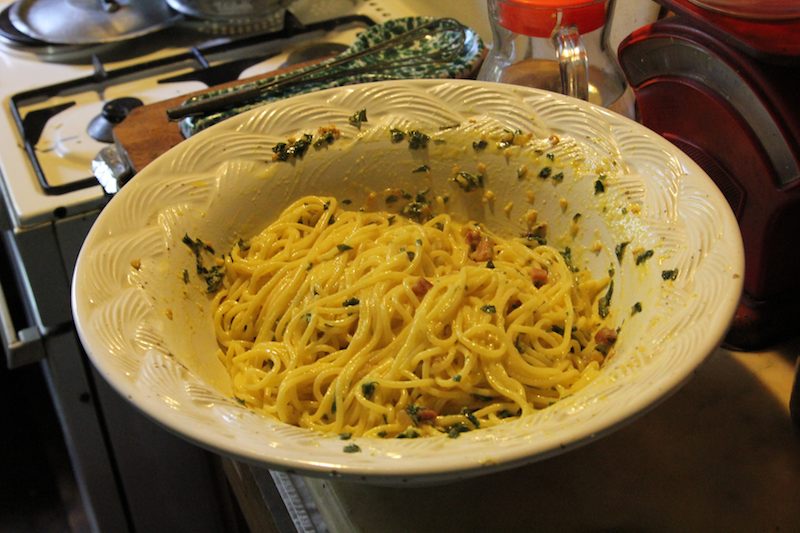
In Italy, I’ve been cooking a lot more than other places. The best part is that I’m actually learning how to cook better which was one of my goals for this trip. So, for Devon’s birthday I set out to cook him a scrumptious meal. He wasn’t in the mood for a pasta with tomato sauce because we’d had a lot of that. He wanted carbonara instead – a pasta with an egg sauce.
My dad makes a great carbonara pasta so I just tried to re-create that. The result is the above pasta. When Devon, our host Ugo, and I sat down to eat my creation Devon and I were pleased. But, our host had a small suggestion. “For me,” he said, “this pasta is overcooked. The Italian way is to make it more al dente.” I thought I’d done that, but according to our host it still wasn’t the Italian way. So I asked him how it was done “the Italian way.”
He told me, the trick is to take the pasta out of the water before you think it’s ready. When you cook pasta you normally taste is until you think it’s soft enough to plate. In Italy that’s too late. You should actually take it out while it’s still a little on the hard side, just a little harder than you’d want it in the meal. The reason for this? The pasta continues to cook in the hot water while you get your colander ready, it cooks in the colander while it’s draining and it cooks in the bowl while you’re mixing it with the sauce. By the time it hits the table, it’s perfect.
I took his notes and applied it to our pasta the next day (making another dish my dad cooks). When I asked Ugo if the pasta was cooked more appropriately this time, he said, “Oh, I didn’t even notice. That means it’s good!”
Success!
For foodies out there, here’s the recipe for the carbonara I cooked. Note, I did this without a recipe, so the portions are not set in stone. If you want more prosciutto, parsley or parmesan just add it. It won’t kill the dish. It’ll just make it better:
Serves 4-5
1/2 a package of spaghetti (one of the smaller boxes or bags)
2 tbsp EVO
4 raw eggs
1/2 cup – 1 cup finely grated parmesan (depending on your taste)
1 cup fresh Italian parsley (English parsley will do as well)
6-7 slices of prosciutto (it’s kind of to taste, so you can do more or less)
4 cloves of garlic
Instructions:
1. Put a large pot of salted water on to boil (obviously, add pasta when it comes to a boil)
2. While that’s heating, finely chop the prosciutto, garlic and parsley.
3. In a small to medium sized frying pan, saute the garlic over medium heat. Move it around a bit so it doesn’t burn.
4. After 2-3 minutes, add the parsley and prosciutto to the garlic and EVO and saute all together until the prosciutto is cooked.
5. Meanwhile, find a large serving bowl (what you’d like to serve the pasta in) and crack the 4 eggs into it.
6. Mix the parmesan in with the eggs and beat together.
7. Once the pasta is almost ready to be strained add the prosciutto to the egg mixture.
8. Strain the pasta and without washing it add the hot pasta to the egg mixture. Mix all together fully. As the hot pasta mixes with the egg, it’ll cook the egg onto each strand of pasta. Timing is of the essence so don’t let the pasta cool and especially don’t wash it with cool water.
9. Serve with a green salad and crusty bread, if you’re so inclined.
P.S. Message to dad – you’ll probably go and look in your recipe book for this dish now and see my portions are a bit off, but it’s the best I could do while in Italy without your cook book and guidance 😉
Posted: August 30th, 2010 | Author: Halbe | Filed under: Italy, Tuscany, Umbria, Wine | 1 Comment »
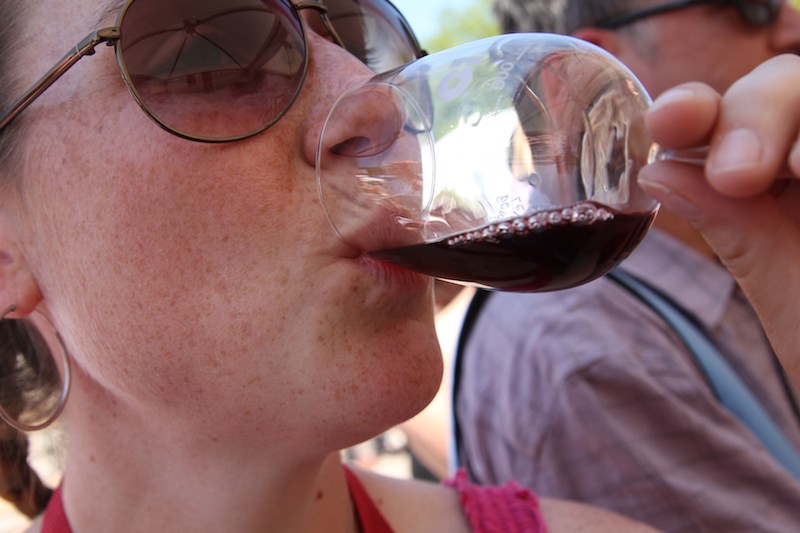
Red wine was never favorite of mine. It was usually overly strong, heavy and sometimes too “in your face.” Being in Europe though, I have grown an appreciation for red wine and now enjoy it quite a lot. In fact, I’d even say, in some situations, I prefer red wine.
The reds we tasted in France were wonderful, especially from the Bordeaux and Bergundy area. What’s finally pushed me to the other side, though, are the reds in Tuscany and Umbria. We’ve had multiple reds that really impressed us. In Tuscany, we bought a bottle of Rosso di Montepulciano, which uses two grapes I wasn’t familiar with: sangiovese 90% (the primary grape used in Tuscany) and canaiolo nero 10% (which has a distinct violet flavor). It’s probably my favorite red I’ve had on this trip so far.
The wine is also incredibly cheap. It was reasonable in France for American standards, but in Italy, it’s dirt cheap. Devon and I went to a wine bar and I was served a Tuscan red which cost 2.50 euros (around $3). Those are serious happy hour prices and it was 9:00 p.m.! I’m going back to the states with a much greater appreciation for red wine. You won’t hear me say “I prefer white,” anymore. Because in Italy and France, I’m a red girl.
Posted: August 28th, 2010 | Author: Halbe | Filed under: Los Angeles | 5 Comments »
After going through seven helpx hosts and four countries, Devon and I have been compiling a list of things we want to have in our lives when we get back to the states. Some of these are long term ideas, and some can happen immediately. Below is the list, which is constantly being added to:
1. Ducks – they’re much more rad than chickens and their eggs are just as delicious, and larger.
2. Hammock – we’ve read many a book and have been swung asleep in the hammocks in Umbria. Apparently the best are from Guatemala.
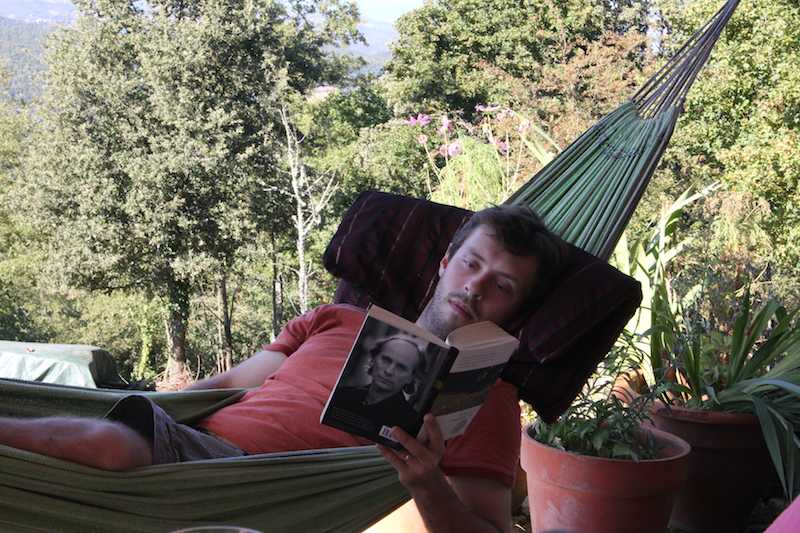
3. Large patio/deck – we want an outdoor living area with sofas, chairs and tables. Meals are wonderful on them and it creates an atmosphere that we both really enjoy.
4. Herb and salad garden – there’s nothing better than sprucing up cooking with fresh herbs and making salad with lettuce picked that afternoon.
5. Dog – we both grew up with dogs and we really miss having them around. Most hosts have had them and it’s reminded us how much we love living with dogs.
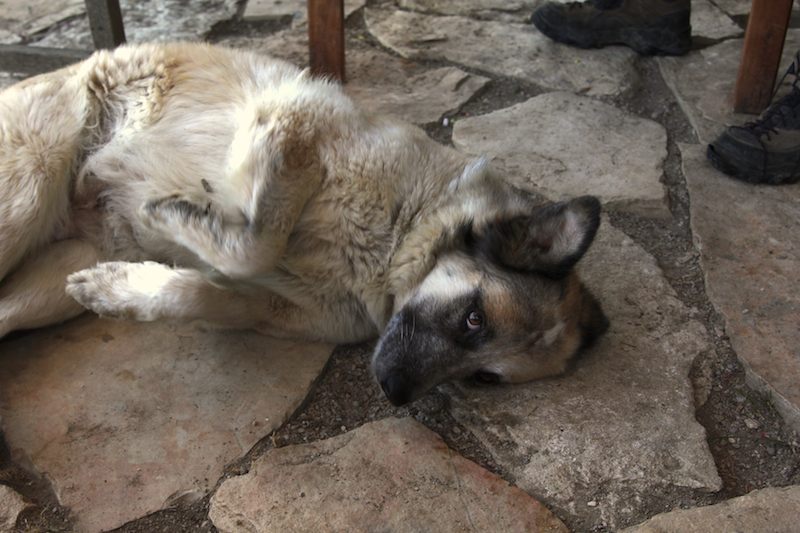
This was our favorite dog on the whole trip, Carina. She was our companian on most hikes in Umbria.
6. Roses – I tended roses in Normandy. I found working with them to be relaxing, and the reward large – they’re just so gorgeous.
7. Cast iron wok – I’ve done a lot of cooking on the trip and the wok has been a staple with most meals. I even fry pasta in it.
8. System for reclaiming water – our hosts in Devon County reclaimed a lot of their rain water to feed their animals. It was inspiring and very doable.
9. Meet more people – we’ve met more wonderful strangers than we ever anticipated. It’s easy to stick with people you know and not reach out, but when we get back, we’d like to change that.
Posted: August 27th, 2010 | Author: Halbe | Filed under: Italy, Tuscany | 2 Comments »
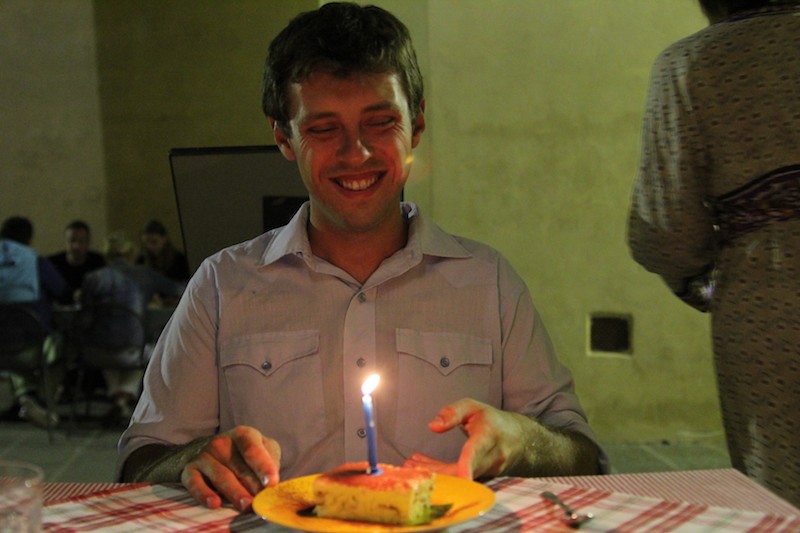
Devon’s 29th birthday was on August 18th and we spent it at a little restaurant in a nearby hill town of Tuscany called Castelmuzio. We had a delicious meal. It started with bruschetta mista (mixed bruschetta) as an antipasta that had toppings of eggplant, sausage, peppers and tomatoes. As an entree, Devon had gnocchi with mushroom sauce and I had stuffed eggplant. This was all washed down with a bottle of water (they don’t serve tap here) and 1/2 a liter of house red wine.
For dessert, which we obviously couldn’t skip, Devon had his favorite Italian sweet, tiramisu, and I had a chocolate pudding with mascarpone sauce. The tiramisu was by far one of the best I’ve had and Devon said it’s the best he’s ever had. The tiramisu was served with a candela and all the waitresses passed with birthday wishes, “Auguri!”
Posted: August 12th, 2010 | Author: Halbe | Filed under: Italy, Meals, Umbria | 6 Comments »
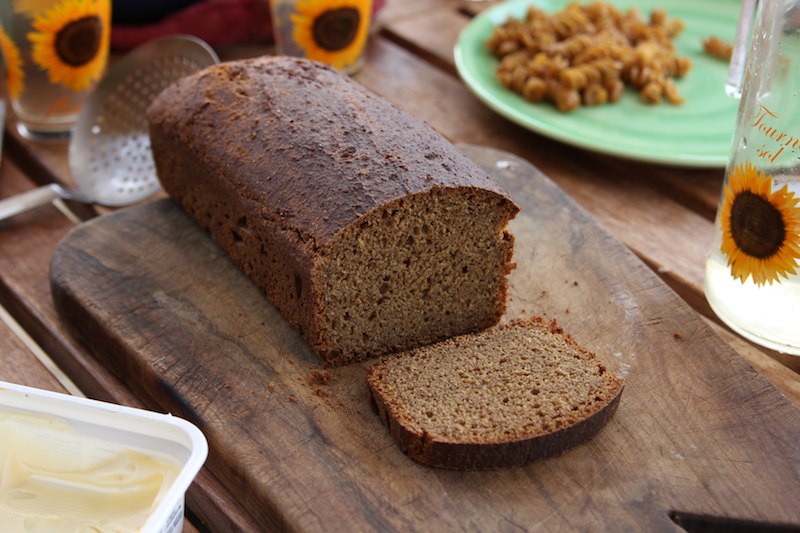
Halbe's first foray into bread making - and it's vegan!
Okay, I’ll admit it, I’ve always been a little jealous of Devon’s ability to make bread. While in Umbria our host, Michael, asked us to make a loaf. Usually Devon would do this, but he’s baked at least 10 loaves on this trip for our different hosts and was a little baked out. I gave it a whirl. This is the result of my efforts and I’m quite pleased. It’s made with white and wheat flour, vegetable oil, soy milk and molasses (our host was a vegan). You can see the soy margarine in the corner of the picture that was smothered on each piece.
Everyone liked it so much it was gone within a few days and our host brought half a loaf to his girlfriend’s to share. Even though she’s not a “bread eater,” she really enjoyed my bread. I have to say, I’m proud of myself! Now we have two bread makers in our family. Devon still has a hold on the pizza making market though. And we’ll keep it that way because he’s certainly got talent.
Posted: July 15th, 2010 | Author: Halbe | Filed under: Uncategorized | 3 Comments »
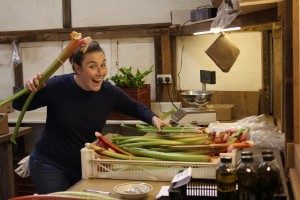
Halbe weighing rhubarb for the box scheme customers in Wales.
On our travels, we’ve heard a few common themes from small producers of organic goods (for ease of writing we’ll call them “farmers”). They don’t like branding and with it, marketing. When Devon and I first heard this at a farm in Wales, we were awe struck. Why wouldn’t they brand their product? If they’re trying to sell what they make, wouldn’t they want as many people to know about them as possible? The answer is a simple, “no.”
At the farm we worked on in Wales, the two owners flat out said they, “didn’t believe in branding.” This coming from two people who live off the income from their farm. They have a box scheme (i.e. they sell boxes of produce to individuals who would pick them up) and went to two farmers markets, weekly. But, they didn’t market their produce beyond that and were even hesitant to use brown paper bags. They feared people might start to associate them with paper bags as a type of branding. This is an extreme example, but many of the farmers we’ve worked with didn’t like branding/marketing either.
We’ve come to a few conclusions as to why this might be. They’re based on direct feedback from the farmers themselves and educated observations we’ve made on our travels. The first is concerned with marketing. They don’t want to work with large grocery stores. Some of the farms we worked with had in fact turned down the opportunity to work with grocery chains (e.g. the farm in Wales). The goat cheese farm we worked at in Cork even severed their partnership with a local chain.
As told by the farmer, the main reason was that they didn’t really make much money working with them. They even lost money. They were selling goats milk – true blue, unpasteurized goats milk. When he first partnered with the store he was thrilled. He’d be able to sell dozens more litres than when he was at the farmers market. Or so he thought. What ended up happening was that he’d give them milk to sell and he’d get money only if the milk sold. In five days time, when the milk expired (it’s very fresh) they’d tell him to pick up what hadn’t sold (which wasn’t much), bring more and they’d even have to decrease the price. So, he’d sold very little milkand it was going to waste. That’s milk he could have used to make cheese which sells for 7 euros/jar.
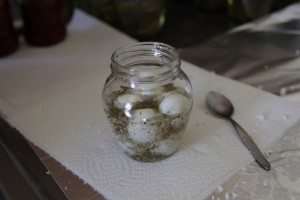
Fresh goat cheese made in Cork - best goat cheese we ever had.
The other reason we thought might play into this is that they prefer to be smaller operations. This way they can control their quality and their work load. They liked being small operations with a few select customers and were perfectly content with the money they made. They loved doing what they did and were pleased just to be making any money from it at all. Expanding was a headache they didn’t want.
What I begin to wonder is what this means for customers who want to eat organic, fresh produce/dairy products but aren’t near a small operation. I understand not wanting to be bigger, but do I need to live in a small town to get fresh eggs, cheese, milk and produce? Not necessarily. There are products at Ralphs that I like, but my point is that it’s not just that the markets don’t work with the farmers, it’s also that the farmers don’t really want to work with the markets.
The issue is complicated and I’m not trying to over-simplify. What I am realizing on this trip is that there are many, many sides to this equation. This one is new to us.














